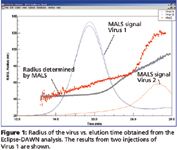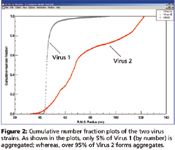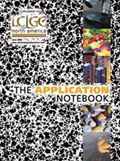Virus Particle Characterization
Viruses are packets of infectious nucleic acid (either DNA or RNA) surrounded by a protective coat consisting of a large number of protein subunits. Since viruses can cause various diseases - some life-threatening - characterizing virus particles thoroughly in terms of their size distribution, aggregation, and absolute counts-per-unit volume is of extreme importance.
Wyatt Technology Corporation
Viruses are packets of infectious nucleic acid (either DNA or RNA) surrounded by a protective coat consisting of a large number of protein subunits. Since viruses can cause various diseases — some life-threatening — characterizing virus particles thoroughly in terms of their size distribution, aggregation, and absolute counts-per-unit volume is of extreme importance.
Though size exclusion chromatography (SEC) has been the primary tool for separating aggregates of molecules, it is generally not appropriate for fractionating viruses because viruses and their aggregates are subject to shearing degradation by the stationary phase. Moreover, they can also be caught by the columns due to their large sizes.
The Eclipse, a particle separation system based upon Fieldflow fractionation (FFF), effectively replaces SEC as a perfect alternative for virus characterization. Since it is analogous to an HPLC separation, the Eclipse — combined with MALS — makes a physical separation of the particles and then sizes them directly as they elute.
This application note reports the results obtained from a set of virus particles fractionated by Eclipse and sized by the 18-angle DAWN EOS on-line multi-angle light scattering instrument.
Figure 1 shows the radius measured by the DAWN EOS detector (from initial slope of angular dependence) versus elution time for two different virus strains. The plots show clearly that aggregates were found in both viruses and much more in Virus 2. Results from duplicate injections of Virus 1 show the excellent reproducibility of the Eclipse-MALS system.

Figure 1
The results are also shown by the cumulative number distribution plots in Figure 2. The cumulative number distribution yields quantitative information on the percentage of aggregates present in each virus strain: 5% for Virus 1 and 95% for Virus 2.

Figure 2
The success of the virus characterization demonstrated above confirms that the Eclipse-MALS approach is an indispensable tool for charactering virus particles—and other colloidal particles—in solution. This approach is especially important when the absolute particle distributions are vital.

Wyatt Technology Corporation
6300 Hollister Avenue, Santa Barbara, CA 93117
tel. (805)681-9009, fax (805)681-0123
Website: www.wyatt.com

The Benefits of Custom Bonded Silica
April 1st 2025Not all chromatography resins are created equal. Off-the-shelf chromatography resins might not always meet the rigorous purification requirements of biopharmaceutical manufacturing. Custom bonded silica from Grace can address a wide range of separation challenges, leading to real performance improvements. Discover more about the latest innovations in chromatography silica from Grace, including VYDAC® and DAVISIL®.
5 Things to Consider When Selecting a Chromatography Silica
April 1st 2025Particularly in the pharmaceutical industry, drug purity isn’t just a goal – it’s essential for achieving safety, stability and efficacy. However, purification is easier said than done, especially with challenging molecules like DNA and RNA “oligonucleotides,” due in large part to their diversity and the range of impurities that can be generated during production. Enter DAVISIL® chromatographic silica, with a wide range of pore diameters and particle sizes to meet your specific application, performance and sustainability requirements. Before you choose the chromatography resin for your next purification application, take a look at these 5 considerations.
Automating Protein Purification: Efficiency, Yield, and Reproducibility
March 27th 2025Recent advancements in automated protein purification stress the importance of efficiency, scalability, and yield consistency. This eBook compares different purification platforms, highlighting their impact on downstream applications and demonstrating how automation enhances throughput and process control.
MilliporeSigma: Ultrapure Water for Sensitive LC-MS Analysis of Pesticides
March 25th 2025The aim of the study was to illustrate the efficiency of Milli-Q® water purification systems in eliminating pesticides from tap water, thereby producing and delivering reliable and consistent-quality ultrapure water suitable for pesticides analysis















